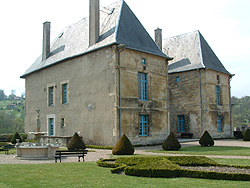 |
 |
 |
 |
 |
 |
 |
 |
 |
|
Bar-le-Duc
|
This town is located 200 km east of Paris. Until 1766 it was part of the independent duchy of Lorraine. In February 1713 King James III and VIII moved to the town. Louis XIV of France was about to sign the Treaty of Utrecht, which required that James not live in France. James stayed first in a house in the rue des Tanneurs (now 22 rue du docteur Nève). 1 While one source describes the house as "small", 2 another says that it was "at the time 'the principal house' in the town, the property of one of the most distinguished residents, Councillor of State M. Marchal". 3 The three-storeyed house is located on the north-west corner of the intersection of rue du docteur Nève with the little lane called rue Saint Antoine. Today the building houses the offices of an insurance firm, the Caisse Departementale des Incendies de la Meuse. There was some brief delay (less than two weeks, however) before the Duke of Lorraine was able to make the his château in Bar available for James. Presumably this was because most of the château had been destroyed by French troops in 1670, and the duke had not actually been restored until 1697. All that remains of the château today is the so-called Château Neuf which houses the Musèe Barrois (open Monday to Friday from 2.00 p.m. to 6.00 p.m.; Saturday and Sunday from 3.00 p.m. to 6.00 p.m.) James is remembered for having permitted a Protestant chapel in the château (something which had not been legally permissible in France). 4 James' mother Queen Mary (widow of King James II and VII) visited her son while he was at Bar-le-Duc. 5 She arrived on June 22, 1715, and returned to Saint Germain on August 22, 1715. She stayed in the house in the rue des Tanneurs. While stationed at Bar-le-Duc, James made many trips to the surrounding towns (including during his mother's visit). He visited the Duke of Lorraine at Nancy and at Luneville, the Prince du Vaudémont at the Château de Commercy, and the mineral baths at Plombières. On at least one occasion he went to Paris incognito, visiting his mother at Chaillot. James remained in the duchy of Lorraine until October 28, 1715. He left in disguise and proceeded to France and then to Scotland. Notes 1 Bryan Bevan, King James the Third of England: A Study of Kingship in Exile (London: Robert Hale, 1967), 65. 2 Ibid., 67. 3 Henry W. Wolff, "The Pretender at Bar-le-Duc", Blackwood's Magazine 156 (no. 1446, August 1894), 233. Wolff's article (pages 226-246) is something of an oddity; he writes in a rather casual style and hardly cites any sources, and yet obviously the article is based upon extensive use of archival resources. 4 Bevan., 67. 5 Wolff, 239-240. |
|
This page is maintained by Noel S. McFerran (noel.mcferran@rogers.com) and was last updated July 25, 2005. © Noel S. McFerran 2003-2005. |
